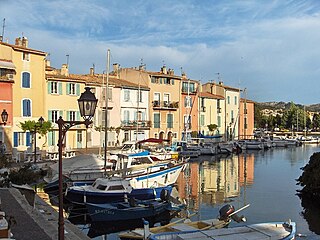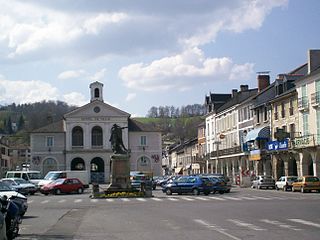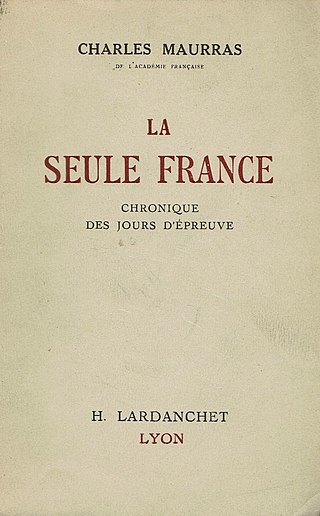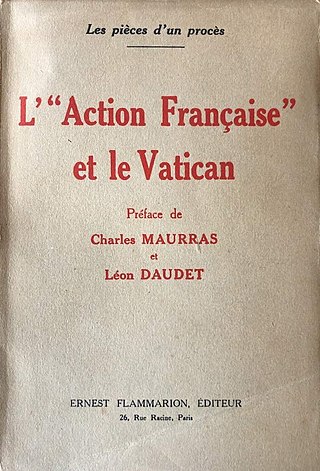
Charles-Marie-Photius Maurras was a French author, politician, poet, and critic. He was an organizer and principal philosopher of Action Française, a political movement that is monarchist, anti-parliamentarist, and counter-revolutionary. Maurras also held anti-communist, anti-Masonic, anti-Protestant, and anti-Semitic views, while being highly critical of Nazism, referring to it as "stupidity". His ideas greatly influenced National Catholicism and integral nationalism, led by his tenet that "a true nationalist places his country above everything".

Martigues is a commune northwest of Marseille. It is part of the Bouches-du-Rhône department in the Provence-Alpes-Côte d'Azur region on the eastern end of the Canal de Caronte.
Integral nationalism is a type of nationalism that originated in 19th-century France, was theorized by Charles Maurras and mainly expressed in the ultra-royalist circles of Action Française. The doctrine is also called Maurrassisme.

Saint-Prosper-de-Champlain is a municipality of 516 people in the Les Chenaux Regional County Municipality, in Quebec, Canada. It is the smallest municipality in terms of population in the regional county.

Nay is a commune in the Pyrénées-Atlantiques department in south-western France. It lies in the former province of Béarn.

The Maison Saint-Gabriel Museum is located in Montreal, Quebec and is dedicated to preserving the history, heritage and artifacts of the settlers of New France in the mid 17th century. The museum consists of a small farm, which has been administered for more than 300 years by the Sisters of the Congregation of Notre Dame of Montreal, founded by Marguerite Bourgeoys in Montreal in 1658.

Tournon-d'Agenais is a commune in the Lot-et-Garonne department in south-western France.
Georges Suarez (1890–1944) was a French writer, essayist and journalist. Initially a pacifist, then a collaborator, he was also the biographer of Pétain and other figures of the French Third Republic. He was the first journalist sentenced to death during the Épuration légale.
Charles Le Quintrec was a French poet. He was born in Plescop and died in Lorient in Brittany.
Robert Margerit was a French journalist and writer.

Yves Morvan is a French archaeologist, specialist of the romanesque art and of the iconography of Blaise Pascal. He is also a restorer, sculptor of religious characters, as well as member of the Academy of Science, Literature and Arts of Clermont-Ferrand.

Raymond Haroutioun Kévorkian is a French Armenian historian. He is a Foreign Member of Armenian National Academy of Sciences. Kevorkian has a PhD in history (1980), and is a professor.

Georges Poisson was a French art historian.

Charles Silvestre was a French regionally inspired novel writer. A friend of Charles Maurras, he would collaborate with the Action française.

The Sillery Heritage Site is an area containing historic residences and institutional properties located in the Sainte-Foy–Sillery–Cap-Rouge borough of Quebec City, Quebec, Canada. It was the first of 13 declared heritage sites of the Province of Quebec, and is among the four of which are located in Quebec City. Having been called the "cradle of the French Canadian nation," the heritage site includes approximately 350 buildings along 3.5 kilometres of the Saint Lawrence River shoreline. The Sillery Heritage Site includes buildings constructed during every major period of Quebec's history, dating back to the time of New France.

Marius Plateau was a French engineer, WWI sergeant, and French Royalist militant. Plateau was an editor of Action Francaise and a former secretary general of the Camelots du Roi. In 1923, Plateau was assassinated by the French anarchist Germaine Berton, who was later acquitted.

La Seule France is a book published in 1941 by the journalist and French politician Charles Maurras, director of L'Action française. Maurras supports an isolationist position between Nazi Germany and Great Britain during World War II, and was resolutely opposed to collaborationism.

L'Allemagne et nous is a book by French journalist and politician Charles Maurras, director of L'Action française, published in 1945. The text takes up the defense of the Cour de Justice du Rhône held between January 24 and 27, 1945 after the Liberation of France. The statement retrospectively explores the position of Action Française vis-à-vis Germany during the first half of the 20th century.

L'Action française et le Vatican is a book by the French journalist and politician Charles Maurras, director of L'Action française, published in 1927. The text is a collection of letters, articles and statements relating to the condemnation of Action Française by Pope Pius XI.
L'Idée de la décentralisation is a political booklet by the French journalist and politician Charles Maurras, member of the Félibrige then journalist and director of L'Action française, published in february 1898.




















